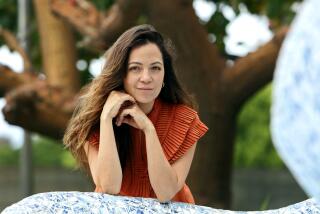Review: Stodgy is out, joyful is in: How Nicholas McGegan brings Handel and heart to the Hollywood Bowl
At the Hollywood Bowl, parts of August and early September have been called the summer doldrums by some — and they can be right. Fortunately, the Los Angeles Philharmonic has hit on one perennial plan to keep the blahs away for at least a week: having Nicholas McGegan on the podium to conduct his 18th century specialties.
That did the trick on Tuesday night, when McGegan led an all-Handel evening, an accumulation of orchestral greatest hits, high-powered choral workouts and ornate showcase arias for a star diva. The mix turned out to be very agreeable, parceled out in bite-size pieces that wouldn’t have challenged most limited attention spans. As a pocket introduction to Handel’s universe, this program would have fit comfortably and usefully on a single CD.
The diva du jour was the Texas-raised mezzo-soprano Susan Graham, who played the role to the hilt with her entrances and statuesque presence. She remains in control of a big, opulent, expressive, just flexible-enough vocal instrument, nimbly negotiating the twists and turns of “Dopo notte” from “Ariodante” and “Se bramate” from “Xerxes” at race-track tempos. She exuded authority in “Ombra mai fu” from “Xerxes” and in the pathos of “Scherza infida” from “Ariodante.”
SIGN UP for the free Essential Arts & Culture newsletter »
True, there was outsized amplification at work here, but I heard Graham completely inhabiting the role of Dido last summer in Berlioz’s gigantic “Les Troyens” at San Francisco Opera, and my impressions about the state of her voice outdoors pretty much matched those of her voice indoors.
The Los Angeles Master Chorale didn’t have all that much to do in this Handel mix tape, but the singers made a mighty impact when asked. They came in with a jarring burst of fortissimo fervor near the beginning of the Coronation Anthem No. 1 (“Zadok the Priest”), causing the sound engineers to reach for the volume control. In that and in “Awake the Trumpet’s Lofty Sound” from “Samson,” they produced a robust choral sound full of unbridled joy, clearly enunciating as usual.
Both of Graham’s vocal segments were prefaced by McGegan’s invigorating renditions of some Handelian orchestral standards — a nice, brisk trot through “Arrival of the Queen of Sheba” from “Solomon” and a jaunty pace through the second suite from the “Water Music” (including the famous Hornpipe).
Time was when “Music for the Royal Fireworks” served as innocuous cannon fodder year after year for the whiz-banging clamor overhead at the Bowl’s Fireworks Finale. But that role has since been passed on to others (this year, it’s the rock group ELO’s turn), so now it’s possible to hear the “Fireworks” music without staccato pyrotechnical punctuation. McGegan and the L.A. Phil made it sound stately yet joyful and lighthearted, without the dutiful stodginess of old.
Finally, as a chaser to all of this Handel, came the “Hallelujah” chorus, with the Master Chorale singing as if it had discovered this well-worn piece afresh. Yet one tradition seems to be fading: I counted only 16 people in the lower boxes who stood while it was played.
Follow The Times’ arts team @culturemonster.
ALSO
‘Exterminating Angel,’ the most important opera of the year, proves it’s here to stay
Pomp trumps polish at Dudamel-led Latin American music concert at Hollywood Bowl
Dudamel and Wang deliver a ‘Rhapsody in Blue’ for the Hollywood Bowl history books
More to Read
The biggest entertainment stories
Get our big stories about Hollywood, film, television, music, arts, culture and more right in your inbox as soon as they publish.
You may occasionally receive promotional content from the Los Angeles Times.










